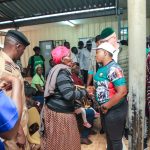Community leaders drawn from at least fourteen informal settlements in Nairobi have lauded the Government’s effort to enable thousands of residents living in slums to access modern structures through the Affordable Housing Programme.
The Settlement Executive Committee (SEC) and Grievance Redress Committee (GRC) leaders, in a recent meeting with a team from the Second Kenya Informal Settlements Improvement Project (KISIP 2) led by Head of Community and Gender Inclusion Ms. Gladys Juma and Shamsa Abdi, reiterated their unwavering support and commitment in supporting the initiative.
Terming the move as a game-changer for them, the leaders added that residents living in informal settlements deserve a better life.
During the meeting, it was noted that these settlements have been characterized by a lack of proper housing structures, which have exposed vulnerable groups including children, youth, the elderly, persons living with HIV AIDs, and the internally displaced to a dilapidated environment.
“You are the champions in ensuring the Government gives a proper facelift to these settlements. KISIP2 is currently carrying out various interventions through its components,” said Gladys Juma
Some of the settlements represented included Kambi Moto, Redemeed, Soweto Kahawa, City Carton, Pumwani Majengo, Fire Victims Kiamaiko, Spring Valley Kayole, Matopeni Kayole, Mji wa Huruma, Mathare Fire Victim, Ngunyumi, Embakasi village and Soweto Kayole.
Under the plan spearheaded by the State Department for Housing and Urban Development, social housing is an important asset to these households since it will allow them to start enterprises, protect them from floods during rains, and prevent their house from getting damaged during natural calamities like the recent El- Nino rains witnessed.
Affordable Houses will serve as a form of social protection for the poor coupled with other direct and indirect benefits like job creation, improved health and sanitation, safety, security, and increased household resilience.
Studies estimate that only two percent of the formally constructed houses target lower-income families, with about 65 percent of Kenya’s urban families having to cope with the informal settlements.





